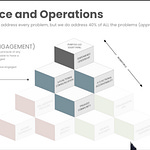For five years, the company sat comfortably at $45 million in revenue. Profitable and predictable, but leadership couldn't figure out why they weren't growing. Every year, they'd set sales targets to find product upgrades and refine their marketing and thought leadership. On the surface, leadership thought everything looked fine. But beneath the surface, something was wrong.
No matter what leadership tried, new strategies, new hires, new technology, the company couldn't break past its ceiling. Every year, the same revenue, the same challenges, the same frustrations. What they didn't realize, their company wasn't just stuck, it was slowly rotting from the inside out. They'd been doing the same thing for too long.
One of the executives who knew of the LucidOrg methodology knew they needed to address a number of the underlying issues to break down silos, realign teams, and create measurable lasting impact. A proposal was made, but the leadership team wasn't ready. They hesitated, saying they were too busy, they had other priorities,
and they just needed to focus on growth. So instead of taking organizational efficiency company-wide, the only option was to focus on one department and see if proof would help. So that's what we did.
The results? In just three months, that department doubled its output. Productivity soared, bottlenecks disappeared, morale hit an all-time high, and every key metric shattered expectations. And the rest of the company took notice. Suddenly, efficiency wasn't just an idea, it was a proven advantage, a model for success, and a blueprint for scale.
With this success in hand, we made another push. It was time to take efficiency company-wide to eliminate the bottlenecks, strangling performance, to drive accountability, and empower leaders at every level.
Leadership pushed it off once again due to the same firefighting, same end of year priorities, and a continued laser focus on growth. And because of that refusal, the same silent killers that had been draining the company for years remained untouched. Things like cross-functional accountability, Departments still operated in isolation, pulling in different directions instead of a shared goal.
The rigid hierarchy suffocated innovation. Employees with innovative ideas weren't heard. Decisions moved at a crawling pace. Disempowered leadership. Instead of making bold, decisive moves, leaders were stuck following simple, outdated protocols. and the alignment gaps widened. Without a unified purpose, teams moved slower, mistakes piled up, and progress stalled. The result? Nothing has changed.
It's been four years since that moment. Revenue still flatlined, margins thinner than ever, client satisfaction, a continued deterioration, employee engagements at an all-time low, and turnover continues to increase and is higher than market. The most frustrating part, this wasn't inevitable. The proof was there. The success of one internal department showed what was possible,
but leadership's in action to implement change turned stagnation into a slow, painful decline. The company isn't dead, but it's dying. It has a reputation for leadership toxicity making recruiting difficult, investors are uninterested in flatline growth, and the competitors are quickly taking market share. At this point, Whether it's a slow death or a fast one doesn't even matter.
The result's the same. If you don't focus on organizational efficiency, it's either stagnation or death.
Organizational efficiency isn't a nice to have. It's not a luxury. It's a necessity. The choice isn't whether to implement. The choice is when. Companies that embrace it early unlock growth. Companies that ignore it either stall or collapse.
This is what happens when leadership refuses to act. Don't let your company become another case study in stagnation.
For additional insight: LucidORG.com










Share this post